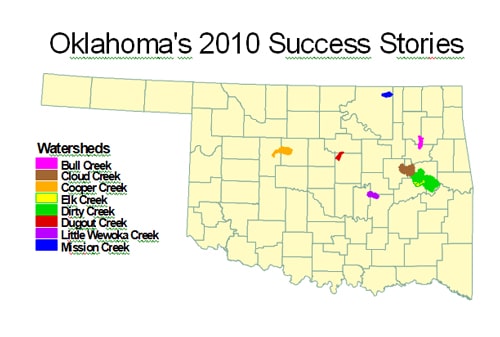Oklahoma’s 2010 Water Quality Success Stories
EPA Announces Most Successful Year in History for Nonpoint Source Water Quality Program
Monitoring and assessment efforts by the Oklahoma Conservation Commission have led to removal of eight additional streams from Oklahoma’s proposed 2010 impaired-waters list submitted to the Environmental Protection Agency this past summer. Commonly referred to as the 303d list, this section of the state’s Integrated Report contains those waterbodies that don’t support one or more water quality standards due to impacts by such pollutants as sediment, bacteria, and excess nutrients. Streams are delisted when data indicates they are again meeting standards.

Approximately 500 streams statewide are monitored on a rotating basis by the Oklahoma Conservation Commission (OCC). The resulting data is assessed using state rules to determine if waterbodies are attaining water quality standards or are impacted by pollutants, particularly those from nonpoint or diffuse sources.
Oklahoma’s conservation partnership, including the USDA Natural Resources Conservation Service (NRCS), local conservation districts and OCC, works with farmers, ranchers and other landowners to address streams with water quality challenges through voluntary, locally-led implementation of best management practices. Last year four streams had documented improvements in water quality that were due to the voluntary implementation of landowners in Oklahoma.
“Effective implementation is key to the success of our nonpoint source management program in Oklahoma,” said Mike Thralls, OCC executive director. “Voluntary participation by landowners, with assistance from state and federal cost-share programs, puts best management practices on the ground that improve water quality while preserving agricultural production interests. The positive, documented results of the conservation partnership’s efforts on water quality are many and have set Oklahoma apart as a leader among programs nationally,” Thralls said.
In February 2010 OCC announced that EPA had removed Wolf Creek in the northwest, California Creek in the northeast, Little Wewoka Creek in central Oklahoma and Little Elk Creek in the southwest from the 303d list. In addition another 170 streams in the state were shown to meet most of the state’s water quality standards and wouldn’t be listed for these pollutants, due again largely to work done by the agriculture producers and other landowners in these watersheds.
The new streams removed from Oklahoma’s proposed 2010 303d list include Bull, Cloud, Dirty, and Elk Creeks in the eastern central part of the state, Mission Creek in north central Oklahoma, and Cooper, Dugout, and Little Wewoka Creeks in central Oklahoma. New data shows these streams to have improved from impacts from one or more issues such as turbidity, dissolved oxygen, and bacteria.
The creeks and the counties where they are monitored:
- Dirty Creek — Muskogee, McIntosh
- Elk Creek — McIntosh
- Cloud Creek — Okmulgee, Muskogee
- Delaware Creek — Osage, Tulsa
- Mission Creek — Osage
- Bull Creek — Rogers, Mayes, Wagoner
- Little Wewoka Creek — Seminole, Okfuskgee, Hughes
- Dugout Creek — Lincoln, Payne
- Cooper Creek — Blaine, Kingfisher
